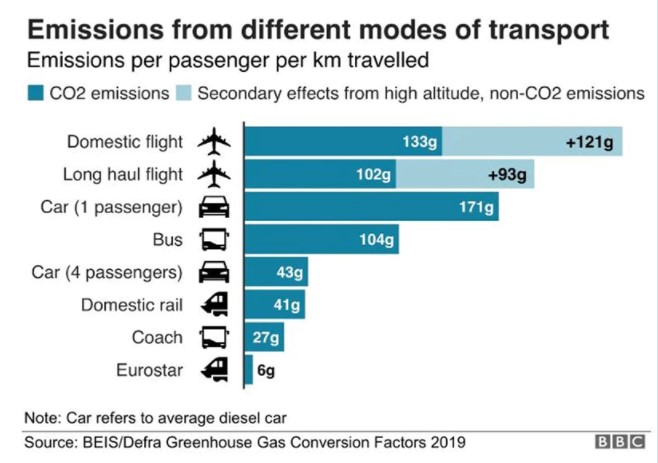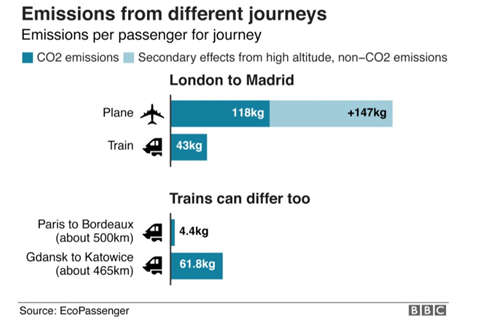21 October 2021
Emissions from travelling are a significant component of an event’s footprint. There are multiple factors that influence the total number of these emissions such as location, number of attendees, weather, individual behaviours, and others. Two of the most commonly used transportation modes for event attendees are the aeroplane and the train. Of course, the use of the one does not exclude the use of the other for the same trip.
What do we know about aeroplanes’ environmental footprint?
As we mentioned in a previous blog, aviation accounts for around 2.5% of global CO2 emissions. This is actually only part of the industry’s emissions. If we add the emissions from processing and distributing aviation fuel, manufacturing and maintenance of aircrafts, ground support vehicles and airports, the number increases significantly. CO2 emissions are most frequently discussed when looking into the environmental impact of an aeroplane journey, not only because it’s an important GHG (greenhouse gas), but also because it is easier to measure. Back in 1999, the Intergovernmental Panel on Climate Change (IPCC) brought to light that the impact of non-CO2 aircraft emissions at high altitudes is higher than the impact of CO2 emissions alone. While two decades have passed putting a number on these has proven a challenging task. Plane engines generate a variety of outputs, including nitrous oxide, water vapour and soot. At the ‘cruise phase’ of a flight, in the upper troposphere and lower stratosphere, these outputs have diverse climatic effects that increase the overall impact of a flight. This is known as aviation multiplier. Another critical point, when looking into the environmental footprint of flying, is whether it is a short- or long-haul flight. Take-off and landing use the most fuel, which means that the longer the distance the less CO2 per person. For example, aircrafts on routes of 700 kilometres or less emit more CO2 per person for every kilometre travelled than long-haul flights: 251 grams per km for short-haul compared to 195 g/km for long-haul.

Is it really greener to go by train?
Compared to flying, using the train emits on average six times less GHG emissions. For rail transport the GHG emissions are determined by rail travel demand in combination with other factors, including the specific energy consumption of the passenger trains (energy per vehicle-km); the number of passengers; rail traffic management procedures; the GHG emission intensity of energy consumed by rail. The specific energy consumption of passenger trains increases with size and weight and depends on the speed and powertrain type. Thus, electric trains are more energy-efficient than diesel trains. This leads to the conclusion that, yes, train rides are greener than flights. The benefits are somewhat reduced as the journey gets longer. This is partly because shorter passenger flights are more polluting per passenger, but also because long train journeys usually necessitate sleeping onboard. If we take into consideration an aeroplane’s non-CO2 warming effects, a train journey will typically be greener, but we have to acknowledge that a long-haul train journey is not inherently eco-friendly.

How can someone calculate their journey’s footprint?
It’s a bit time consuming to go through all the different calculations needed. There are plenty of online calculators that can provide you with a number if you submit your information like starting point, medium, etc. Here are some examples:
Are you thinking about how to improve the sustainability of your event? Find out more about our Sustainable Conferencing Grants and how we can help you to collaborate productively while minimising your traveling impact on the environment for your next scientific event.
Visit our sustainability blogs for more tips.








You must be logged in to post a comment.